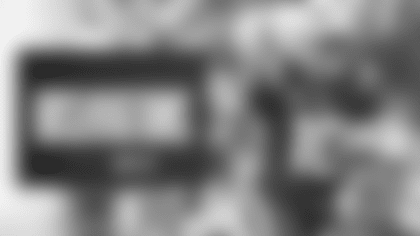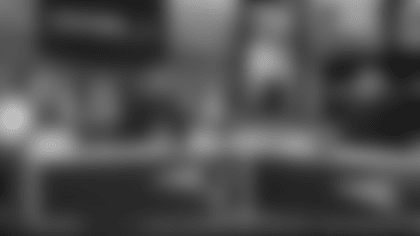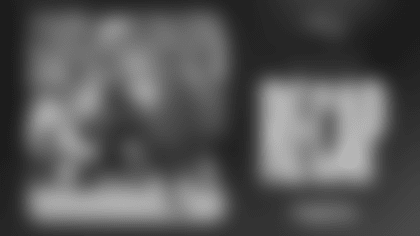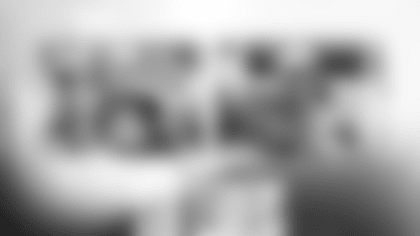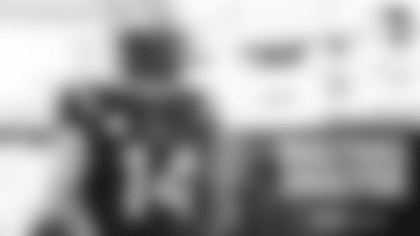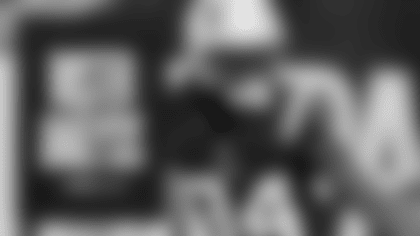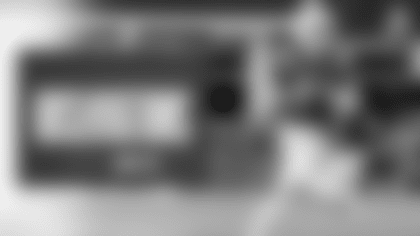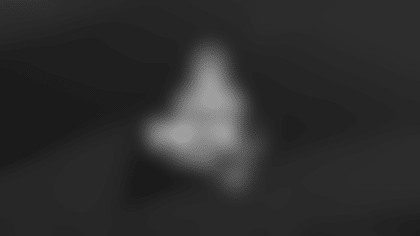The NFL's broadcast partners and TV service providers, as they say, are on the clock.
It was just a matter of time before pro sports programming became available in the emerging 4K ultra HD (UHD) format. The only question now is when someone in the U.S. will follow the lead of UK's BT, which has launched a sports UHD TV channel.
Given the anticipated billions of dollars of infrastructure and camera spending needed to deliver the NFL in 4K UHD, I wouldn't suggest U.S. football fans hold their breath. But what's the cost of broadcasters (who are seeing declines in viewing of their programming) staying on the sidelines?
With BT's U.K. competitors expected to follow suit, and TV service providers in other countries taking a close look, the sports in UHD movement appears to finally be under way, with ramifications for the U.S. and beyond. 4K UHD offers four times the resolution of 1080p HD and eight times that of standard definition (SD).
And though 4K has found small niches in the NFL (assisting referees in instant replay decisions), BT's planned BT Sports Ultra HD channel will become the first of its kind, delivering pro soccer and rugby for those who pay for the web-delivered channel, have a 4K TV and get a set top box from BT. The company is driving interest with a voucher good for 500 pounds off LG UHD TVs.
S.O.S. – Save our Ship
Content owners, broadcast networks and sports channel distributors all need to be looking at UHD sports seriously. Why? Well even "the worldwide leader" ESPN is losing subscribers (a reported 3.2 million in the last year alone). It's playing D by suing Verizon over the way its channels are offered on an innovative new service (FiOS Custom) that lets subscriber's mix and match channels from a limited list far shorter than traditional gazillion-channel lineups. Verizon's CEO said Tuesday that a third of its new FiOS TV subscribers are buying the Custom package.
I cannot think of anything that would help flagging – and increasingly expensive -cable TV package services in the U.S. more than live sports programming in 4K UHD. U.S. cable companies here are losing customers in droves to cheaper alternatives and it's largely sports fans that are paying the freight (and getting little or anything in return) for their money.
It actually goes the other way. Pay TV providers charge all customers a monthly regional sports network (RSN) fee, a monthly broadcast TV fee and in most every case a monthly "sports package" fee for access to channels like the NFL Network.
And when you include periodic rate increases, it's no surprise that subscribers without interest in sports have already (and still are) bailed for inexpensive services such as Netflix and Amazon Instant Video in part to avoid what's being called the "sports tax." Still others are drawn to small channel lineup cable services with small price tags such as DISH Network's Sling TV (which can be set up without sports channels).
The bottom line is that giving live sports fans a reason to stay, as in 4K, could stem the tide of cord cutters. BT is giving sports fans this benefit in a cost effective way that TV service providers here in the states should be taking a very hard look at (and talking to their broadcast network partners about ASAP).
Get the Picture?
Perhaps part of the reason sports in the U.S. aren't yet available in 4K is the existence of an even higher resolution specification, 8K UHD, which Major League Baseball is playing around with. Non-sports 4K programming (mostly movies) is already available from Netflix, DIRECTV, Comcast and a few others on a limited basis.
The seemingly good news is that 4K NFL isn't an "if", but a "when" (one we don't have a date or timeframe for), according to a CBS executive late last pro football season. The better news is that UHD TVs have continued their price plunge and firms such as Comcast are working on 4K set-top boxes.
Remember, it was pro sports that fueled the movement from SD to HD many years ago. Sports has helped advance 4K UHD since, with many one-off international sporting events such as the Olympics and World Cup being shot in the higher-resolution format.
BT says its UHD sports channel represents "a significant step change that will give viewers much sharper pictures and less motion blur. This should be especially noticeable on Ultra coverage of fast-paced sports such as football or motor racing, where camera pans will look much smoother and less blurred."
The company is teaming with global infrastructure vendor Ericsson on the UHD venture.
The New(er) Business Case
When we last left 4K, broadcasters in particular were lamenting the anticipated high cost of the infrastructure (including cameras to shoot the games and related gear) needed to provide sports in 4K UHD. It was unclear how they would monetize these game casts.
Well, a new wrinkle pioneered by BT may help on the revenue said as the TV company claims Sony has put ads (or adverts as they calm them) on individual blades of grass and shoe cleats, two items that are very hard to see clearly in HD, but not in 4K UHD.
Charging advertisers and sponsors more in general for spots in 4K UHD seems like an obvious part of the business case for the higher resolution format.
Set it Up?
Early on, many said the lack of affordable UHD TV sets was a huge negative for the 4K movement. It was. But that has changed as some of the world's largest consumer electronics makers – Samsung, Sony, Vizio and more – continue to crank out the sets and reduce prices as part of wide-ranging promotions or permanent moves.
"Now more than two-thirds of TVs sold in the UK are Ultra HD-ready," claims BT.
I don't have numbers but a growing group of 720p and 1080p HD sets (along with those still on SD TVs) have to be ready for an upgrade. The NFL in 4K would be a compelling one, even if it's part of a gradual introduction, which frankly makes much more sense. All-at-once approaches with tech changes/implementations are daunting. Remember the move for SD to HD?
SD-HD-UHD
Moving from HD to 4K UHD is not the same as the SD-HD move. Those in the business say that the eye doesn't notice a big difference in a side by side eye test until the UHD set is 50 inches or larger. That's why you don't (and won't) see midsize or small UHD sets.
And on the education front, using a 4K UHD set does NOT mean you can't watch HD programming. HD TV is made viewable on the bigger higher resolution sets using a process called 'up conversion.' Oh, and you do not need special glasses to watch the UHD TV.
How BT's UHD Sports Channel

It's important to understand first that the BT UHD sports is but a single channel in a far larger TV package with all the other channels in HD. The company isn't offering anything else in the higher resolution format, at least for now.
To make use of the UHD sports channel, subscribers must first have access to BT's Infinity offering which is its fastest Internet service. The big bandwidth is needed to carry the capacity-demanding UHD programming until advances in compression are productized and implemented. The fiber-based Infinity, supports speeds of 76 megabits per sec, is not available to all consumers.
But UHD isn't a complete bandwidth beast. Industry experts generally agree that roughly 15 megabits is sufficient for 4K UHD programming transmission. Diversified content delivery kingpin Akamai technology, which operates an advanced global distribution network, has estimated that only 12% of global connections are at or above the 15 megabit level. Of course, those numbers will increase. Its quarterly State of the Internet report claimed 55 countries qualified for inclusion in this tracking area.
BT UHD sports seekers will also need a special set-top box which features 1 terabyte of storage and DVR functionality. And, of course, subscribers will need a UHD TV. As part of the package, BT is offering a voucher for 500 pounds off LG UHD sets.
Finally, users will need to subscribe to BT's highest programming package, which includes free a Sports Pack super-loaded with premium sports channels, flexible viewing opportunities and much more. They get 351 exclusively live UEFA Champions League and Europa League matches, the FA Cup, European Rugby Champions Cup, Barclays Premier League, SPFL, Aviva Premiership, MotoGP and UFC.
The Bottom Line
To be realistic, no move from one technology to another is a flash cutover. Remember the gradual move from SD to HD years ago. That said, there' a very clear starting point as BT has shown others by offering a single UHD sports channel as part of a larger programming package.
And yes, the cost of rolling out 4K UHD is large, especially for broadcasters, but with challenges on numerous fronts to its viewer base, can the industry afford to stand pat? I really don't think so. And can TV service providers (cable companies, satellite operators etc.) with their challenges? Same answer.
The NFL is doing quite well and does need UHD TV. But its broadcaster and distribution partners need it to want 4K UHD.
Stay tuned!
Bob Wallace is a technology journalist with over 30 years of experience explaining how new services, apps, consumer electronic devices and video sources are reshaping the world of communications as we know it. Wallace has specific expertise in explaining how and why advances in technology, media and entertainment redefine the way football fans interact with the league, teams, players and each other. He's the Founder of Fast Forward Thinking LLC.

The NFL's broadcast partners and TV service providers, as they say, are on the clock.
It was just a matter of time before pro sports programming became available in the emerging 4K ultra HD (UHD) format. The only question now is when someone in the U.S. will follow the lead of UK's BT, which has launched a sports UHD TV channel.
Given the anticipated billions of dollars of infrastructure and camera spending needed to deliver the NFL in 4K UHD, I wouldn't suggest U.S. football fans hold their breath. But what's the cost of broadcasters (who are seeing declines in viewing of their programming) staying on the sidelines?
With BT's U.K. competitors expected to follow suit, and TV service providers in other countries taking a close look, the sports in UHD movement appears to finally be under way, with ramifications for the U.S. and beyond. 4K UHD offers four times the resolution of 1080p HD and eight times that of standard definition (SD).
And though 4K has found small niches in the NFL (assisting referees in instant replay decisions), BT's planned BT Sports Ultra HD channel will become the first of its kind, delivering pro soccer and rugby for those who pay for the web-delivered channel, have a 4K TV and get a set top box from BT. The company is driving interest with a voucher good for 500 pounds off LG UHD TVs.
S.O.S. – Save our Ship
Content owners, broadcast networks and sports channel distributors all need to be looking at UHD sports seriously. Why? Well even "the worldwide leader" ESPN is losing subscribers (a reported 3.2 million in the last year alone). It's playing D by suing Verizon over the way its channels are offered on an innovative new service (FiOS Custom) that lets subscriber's mix and match channels from a limited list far shorter than traditional gazillion-channel lineups. Verizon's CEO said Tuesday that a third of its new FiOS TV subscribers are buying the Custom package.
I cannot think of anything that would help flagging – and increasingly expensive -cable TV package services in the U.S. more than live sports programming in 4K UHD. U.S. cable companies here are losing customers in droves to cheaper alternatives and it's largely sports fans that are paying the freight (and getting little or anything in return) for their money.
It actually goes the other way. Pay TV providers charge all customers a monthly regional sports network (RSN) fee, a monthly broadcast TV fee and in most every case a monthly "sports package" fee for access to channels like the NFL Network.
And when you include periodic rate increases, it's no surprise that subscribers without interest in sports have already (and still are) bailed for inexpensive services such as Netflix and Amazon Instant Video in part to avoid what's being called the "sports tax." Still others are drawn to small channel lineup cable services with small price tags such as DISH Network's Sling TV (which can be set up without sports channels).
The bottom line is that giving live sports fans a reason to stay, as in 4K, could stem the tide of cord cutters. BT is giving sports fans this benefit in a cost effective way that TV service providers here in the states should be taking a very hard look at (and talking to their broadcast network partners about ASAP).
Get the Picture?
Perhaps part of the reason sports in the U.S. aren't yet available in 4K is the existence of an even higher resolution specification, 8K UHD, which Major League Baseball is playing around with. Non-sports 4K programming (mostly movies) is already available from Netflix, DIRECTV, Comcast and a few others on a limited basis.
The seemingly good news is that 4K NFL isn't an "if", but a "when" (one we don't have a date or timeframe for), according to a CBS executive late last pro football season. The better news is that UHD TVs have continued their price plunge and firms such as Comcast are working on 4K set-top boxes.
Remember, it was pro sports that fueled the movement from SD to HD many years ago. Sports has helped advance 4K UHD since, with many one-off international sporting events such as the Olympics and World Cup being shot in the higher-resolution format.
BT says its UHD sports channel represents "a significant step change that will give viewers much sharper pictures and less motion blur. This should be especially noticeable on Ultra coverage of fast-paced sports such as football or motor racing, where camera pans will look much smoother and less blurred."
The company is teaming with global infrastructure vendor Ericsson on the UHD venture.
The New(er) Business Case
When we last left 4K, broadcasters in particular were lamenting the anticipated high cost of the infrastructure (including cameras to shoot the games and related gear) needed to provide sports in 4K UHD. It was unclear how they would monetize these game casts.
Well, a new wrinkle pioneered by BT may help on the revenue said as the TV company claims Sony has put ads (or adverts as they calm them) on individual blades of grass and shoe cleats, two items that are very hard to see clearly in HD, but not in 4K UHD.
Charging advertisers and sponsors more in general for spots in 4K UHD seems like an obvious part of the business case for the higher resolution format.
Set it Up?
Early on, many said the lack of affordable UHD TV sets was a huge negative for the 4K movement. It was. But that has changed as some of the world's largest consumer electronics makers – Samsung, Sony, Vizio and more – continue to crank out the sets and reduce prices as part of wide-ranging promotions or permanent moves.
"Now more than two-thirds of TVs sold in the UK are Ultra HD-ready," claims BT.
I don't have numbers but a growing group of 720p and 1080p HD sets (along with those still on SD TVs) have to be ready for an upgrade. The NFL in 4K would be a compelling one, even if it's part of a gradual introduction, which frankly makes much more sense. All-at-once approaches with tech changes/implementations are daunting. Remember the move for SD to HD?
SD-HD-UHD
Moving from HD to 4K UHD is not the same as the SD-HD move. Those in the business say that the eye doesn't notice a big difference in a side by side eye test until the UHD set is 50 inches or larger. That's why you don't (and won't) see midsize or small UHD sets.
And on the education front, using a 4K UHD set does NOT mean you can't watch HD programming. HD TV is made viewable on the bigger higher resolution sets using a process called 'up conversion.' Oh, and you do not need special glasses to watch the UHD TV.
How BT's UHD Sports Channel

It's important to understand first that the BT UHD sports is but a single channel in a far larger TV package with all the other channels in HD. The company isn't offering anything else in the higher resolution format, at least for now.
To make use of the UHD sports channel, subscribers must first have access to BT's Infinity offering which is its fastest Internet service. The big bandwidth is needed to carry the capacity-demanding UHD programming until advances in compression are productized and implemented. The fiber-based Infinity, supports speeds of 76 megabits per sec, is not available to all consumers.
But UHD isn't a complete bandwidth beast. Industry experts generally agree that roughly 15 megabits is sufficient for 4K UHD programming transmission. Diversified content delivery kingpin Akamai technology, which operates an advanced global distribution network, has estimated that only 12% of global connections are at or above the 15 megabit level. Of course, those numbers will increase. Its quarterly State of the Internet report claimed 55 countries qualified for inclusion in this tracking area.
BT UHD sports seekers will also need a special set-top box which features 1 terabyte of storage and DVR functionality. And, of course, subscribers will need a UHD TV. As part of the package, BT is offering a voucher for 500 pounds off LG UHD sets.
Finally, users will need to subscribe to BT's highest programming package, which includes free a Sports Pack super-loaded with premium sports channels, flexible viewing opportunities and much more. They get 351 exclusively live UEFA Champions League and Europa League matches, the FA Cup, European Rugby Champions Cup, Barclays Premier League, SPFL, Aviva Premiership, MotoGP and UFC.
The Bottom Line
To be realistic, no move from one technology to another is a flash cutover. Remember the gradual move from SD to HD years ago. That said, there' a very clear starting point as BT has shown others by offering a single UHD sports channel as part of a larger programming package.
And yes, the cost of rolling out 4K UHD is large, especially for broadcasters, but with challenges on numerous fronts to its viewer base, can the industry afford to stand pat? I really don't think so. And can TV service providers (cable companies, satellite operators etc.) with their challenges? Same answer.
The NFL is doing quite well and does need UHD TV. But its broadcaster and distribution partners need it to want 4K UHD.
Stay tuned!
Bob Wallace is a technology journalist with over 30 years of experience explaining how new services, apps, consumer electronic devices and video sources are reshaping the world of communications as we know it. Wallace has specific expertise in explaining how and why advances in technology, media and entertainment redefine the way football fans interact with the league, teams, players and each other. He's the Founder of Fast Forward Thinking LLC.





